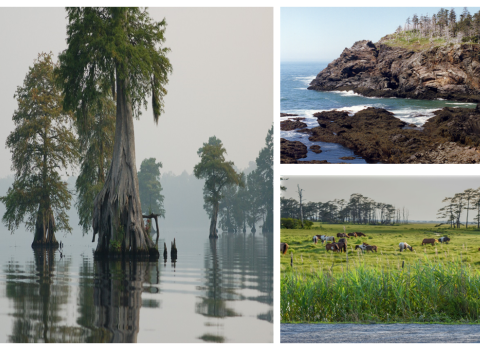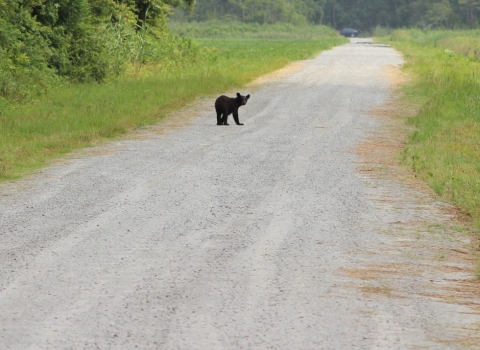By Flora Kerner, Student Conservation Association Intern at the Mid-Columbia Fish & Wildlife Conservation Office
A month after my graduation from Boston University, I followed I-90 (almost the whole way) to Leavenworth, Washington. There, I started a position at the Mid-Columbia Fish and Wildlife Conservation Office as an AmeriCorps and Student Conservation Association fish technician intern. I was ecstatic to explore an entirely novel ecosystem that I had never learned about before. The office undertakes conservation and habitat management efforts in field and hatchery settings for Chinook and coho salmon, steelhead, bull and brook trout, as well as Pacific lamprey.
One of the many duties fish technicians are responsible for are snorkel surveys. For these, we collect data on fish presence estimates to understand population size in various tributaries to the Mid-Columbia River. Bull trout surveys are conducted at night because juvenile bull trout come out from cover at night, so they are easier to count and capture. Bull trout are listed as a threatened species partly due to their habitat complexity and need for cold waters. These surveys are exciting because we are almost guaranteed to see these elusive creatures in their natural habitats.
In late August, I was scheduled to be a part of a three-person bull trout night snorkel crew along with my coworkers LJ and Sylvia. This was my first multi-day snorkel trip, and I hoped we would have good news to bring back to the office. The section of Rock Creek we planned to snorkel required a backcountry campsite and the assistance of a mule team to pack in our heaviest supplies. In preparation for the mule team, we spent the week prior hand and chain-sawing obstacles along the trail up to a pre-determined campsite.
After hiking for 5 miles, our first attempt at trail clearing was suddenly cut short by a plume of smoke and emergency alerts from the office signaling that a small forest fire was underway nearby. With uncertainty on how the following week was going to go, we returned to the office and awaited clearance from the U.S. Forest Service. Following heroic efforts by firefighters, the fire was put out in only two days, and we were approved to continue work in the area.
The Friday before the scheduled snorkel trip, we hiked back out to finish brushing the trail for the mules. Once we finished trail clearing, we took a celebratory lunch at our intended camping spot, but an unfortunate step on a log caused a swarm of yellowjackets to reclaim their territory, sending us running down the trail in search of another campsite. It felt as if we were being tested by nature, seeing how far we would go to ensure the success of the surveys, but we prevailed.
On Monday morning we met with the mules and the mule-packer team at the trailhead to transfer our equipment for the week and establish a meeting point. The hike in was easy and familiar by now, and we had an exciting week ahead of us. Despite their size, mules walk much slower than a team of technicians, so we had some time to relax once we reached our new, wasp-free campsite. When the mules arrived, we unpacked our things, thanked the team, and said our goodbyes. We set up camp quickly and settled down for dinner, getting ready for the night of snorkeling ahead.
A little before dusk, we suited up in our dry suits and gathered our equipment for the night. Our survey reach was two miles from our campsite. We waddled down the trail in our dry suits to the start of the reach and began the survey shortly after dark.
Bull trout snorkel surveys in Rock Creek require two people in the water snorkeling, one person on each side, while the third person walks along the bank. Those in the water have flashlights and underwater slates to record the number, sizes, and species of observed fish. Any juvenile bull trout encountered are netted and passed to the bank person for measurements, photos, tissue sampling, and occasional tagging. All fish are released alive. Each reach is up to 200 meters long, and the surveys typically take three to four hours depending on the number of fish found.
The next morning we had a leisurely wake up to get ready for the busy day ahead of us. Before a night snorkel, we do a habitat survey of the reach to gather information on the river. This data is important for later analysis looking at bull trout abundance along the various reaches and how it relates to habitat. Since we hadn’t surveyed the habitat the day before, we surveyed two reaches before our snorkel that night. For the surveys, we used a depth rod and laser distance measurer to record the depth, width, and length of the river. Then we estimated sky exposure and substrate size distribution as well as noting any logjams along the way that could create potential fish habitat. After surveying the first reach’s habitat, we stopped for a chilly break on some sunny rocks, thankful that Sylvia had brought along a mini burner for some warm lunch. Following the second habitat survey, we found our way back to camp for a quick nap before our nighttime adventure.
After reviewing everyone’s freeze dried dinners and pumping ourselves up with some yummy tea, we put on our dry suits and began our nightly shuffle towards the river. For some reason, it felt easier than the night before to ignore the numbness of submerging my head in 45 F water. During the snorkel, we found ourselves slowly trailing behind two adult migratory bull trout until they vanished into the night. We captured (and released) 32 juvenile bull trout, an all-time high for the office’s snorkel surveys, and spotted a beautiful westslope cutthroat trout. These numbers implied that perhaps the bull trout population in Rock Creek were doing a little better than populations in other areas that had been surveyed. Further investigation would be required to fully understand the reasons behind this population’s success. As we meandered back to camp, we basked in the glory of the night sky and reveled in the finds of the survey.
We woke on the third day to mist and a hint of last night’s snorkel excitement still in the air. Leaving shortly after breakfast, we walked down the trail to survey the reach habitat, stopping every so often to snack on huckleberry bushes along the way. The reach habitat was complex and took some time to navigate through, but it ended at a giant, moss-covered boulder that was a perfect lunch spot. Sylvia and I chose to stay in the comfort of the sunny moss as LJ braved the cold water for a dip. We lingered a little longer before making our way back to camp in preparation for our final snorkel.
At twilight, after finishing our last hot meals and getting dressed up in our dry suits, we began our walk to the river. We trudged down the hill to the water, climbing over fallen trees and moving thick branches from our faces. The fish were enchanting, as always, and we were able to sample a fair amount of bull trout as the moon (and our flashlights) illuminated our path up the river. After making it back to camp, we treated ourselves to some warmth from the stove, holding our hands over the fire before playing a round of Golf, a card game introduced by LJ.
The next morning, as we could hear the mules clopping down the trail, we said our goodbyes to our home for the past week. The walk back was delightful, but too soon we were back at the truck, glad to see it had stayed put in the last few days. As we made our way down the gravel road back to civilization, I reflected back on our trip. Sleeping under the pine canopy and relying on the water from streams nearby, I had felt at one with the Washington nature. Although I still had miles more to explore, my knowledge and admiration for this previously unfamiliar ecosystem was growing. I couldn’t wait for our next adventure up the river … and for a big scoop of ice cream from town.
As part of the Leavenworth Fisheries Complex, the Mid-Columbia Fish and Wildlife Conservation Office evaluates the hatchery production programs, provides technical assistance, and assists the coordination of operations and production. The MCFWCO cooperates with other Service programs, agencies, tribes, and entities using and managing aquatic species and their habitats in the mid- and upper-Columbia River Basin.
Learn more: Mid-Columbia Fish and Wildlife Conservation Office | About Us | U.S. Fish & Wildlife Service







